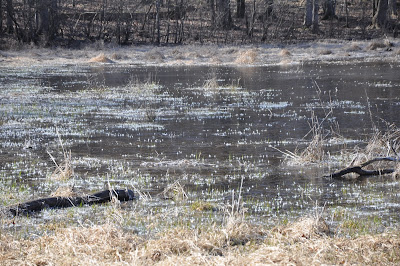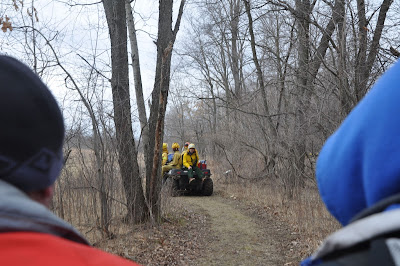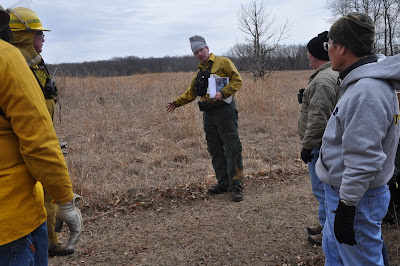One of the really exciting things about a burn is just how quickly the vegetation takes over. There are several reasons for this: the sun can now reach the soil to heat it up (thus germinating the seeds hidden therein), and the blackened soil just speeds this process up; many native seeds in prairie habitats evolved with fire, and thus often need fire to prep them for germination (for some this involves fire melting a resinous coating that otherwise keeps the seed from the light and moisture that would stimulate germination for a regular seed); there is no struggle to get light (in an unburned field, the old dead vegetation creates a barrier that may hinder rapid growth).
So, I got down on my belly, on the charred ground, and snooped around in search of a new green sprout. And there it was!
I was actually quite surprised to see this sprout. All week the temps have been below freezing - both day and night. Not conditions that really trigger growth. This just goes to prove that the sunlight is heating up the dark ground just enough to make things grow, even if only very slowly.
I really should come back once a week and set up my camera at the same place each time and take a shot - see the greening over time.
ANYway - continuing through the burn, I saw a small pile of bones:
I looked around, for I had heard that the Tuesday Morning Group had found old coyote den holes nearby.
I had a lovely view of this tree against the springtime sky. Doesn't this shot just sum up the prairie?
And there, hard by the tree, a pile of white sand caught my eye. This looked highly suspicious. What would cause a pile of white sand in an otherwise blackened and charred landscape?
AH-ha! It was the aforementioned coyote den! The hole to the den is to the left side, with the sand dug out from it piled up around the right side.
Nicely placed on top of the pile of sand was a perfect pile of scats. Definitely coyote. They are white, though. Hm. Knowing that there are no snowshoe hares around here, this meant that these were probably older scats. Older because they are white with age, or older than the fire and they are ashen from the blaze. Whatever the reason, they aren't terribly fresh.
Here you can see the placement of the scats next to the den entrance. Notice also the pieces of vegetation across the entrance. One of the Tuesday Morning Group did this as a test to see if the den was active. If it is, then the vegetation would be moved aside. If the vegetation remains in place, then the coyotes are no longer here.
Two more entrances were located just downslope from the first. One still had vegetation across the opening, but the other did not. Hm...perhaps the den is not completely abandoned.
And here you can see all three entrances, forming a nice little triangle!
The coyote den wasn't he only source of holes. Here we have some much smaller tunnels going below ground. Voles? Mice?
And more greenery showed up as I continued to look! This thistle is doing quite well.
As is this mullein. Mullein has very thick and fuzzy leaves to begin with, which makes it well-suited for growing early in the season when cold temperatures are very likely. Thus protected, it doesn't feel the bite of winter's cold.
Ah. Now here is an important view of the prairie, a view that demonstrates why native grasses are so important to these ecosystems. Here is a view of the restored portion of our prairie:
...and a view of the prairie where non-native plants dominate:
Do you see the difference?
Once again, the native portion:
...and the non-native (conveniently side-by-side):
Here is the answer:
Clumps of native grasses. Looking at the restored area, you see lots of charred bumps - these are the native grasses, which will resprout once things warm up a bit. Native grasses grow in clumps that are dispersed across the open ground. Non-native grasses tend to grow in mats - solid mats that don't clump up.
This is an important concept. If you have native grasses, then there is space in between them for other native plants, like the many wildflowers and other forbs that call prairies home, to grow. Additionally, these spaces give wildlife (small wildlife) places to move, and places to hide. And, when winter comes around, native grasses remain tall, providing additional shelter (and food) for small birds. Non-native grasses tend to just smoosh down under the weight of winter's snows. This might provide some nice protection for small mammals traveling below the surface of the snow, or it might not - maybe it hinders their travel by being so compact. Hm. Something to ponder.
Well, the morning was moving along toward noon, and I had plenty of work to do back in the office, so I headed back. Along the way, though, I did find some more proof that spring is in the offing:
Woodland flowers are sending up their leaves, soon to be followed by stems and flowers. Woodland flowers bloom before the trees fully put out their leaves, taking advantage of the sunlight while they can.



























































